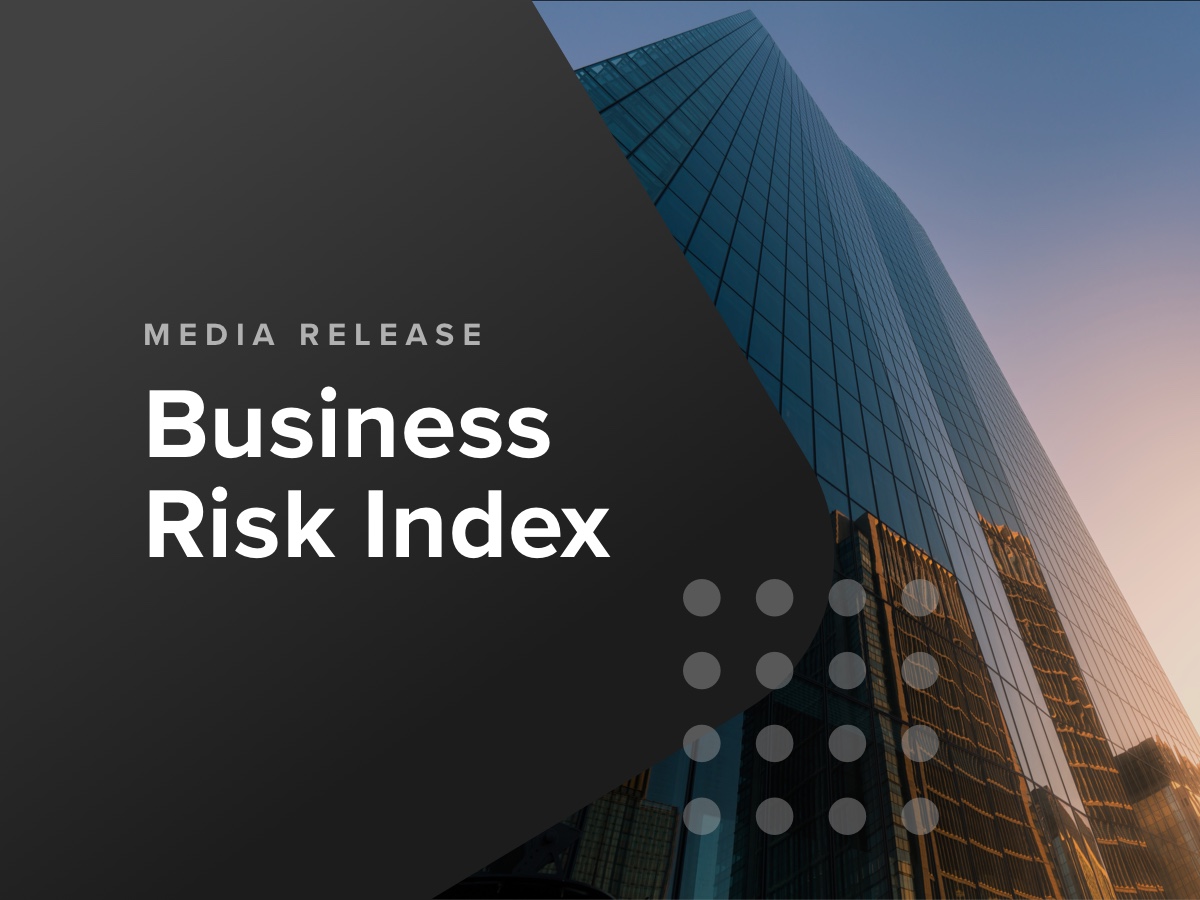Economy at turning point as positive trends continue; Grim outlook for flood-affected regions
In our latest episode, we present the January Business Risk Index results and analysis. CreditorWatch CEO Patrick Coghlan and Chief Economist Anneke Thompson discuss the key insights.
Key Business Risk Index insights for April:
- Trade receivables and credit enquiries continue to trend upwards, indicating the broader economy many have reached an inflection point.
- Average trade receivables for April were at their highest level since July last year.
- Credit enquiries decreased from March to April but are still up 30 per cent quarter-on-quarter.
- Multiple adverse impacts will likely temper this positive data over the coming months.
- The Business Risk Index national default rate remained flat at 5.8 per cent in April, however CreditorWatch forecasts a continued rise across 2022.
- There was stabilisation across industry default rates in April.
- Court actions decreased from March to April but are still up 12 per cent year-on-year.
- Victorian Grampians is the lowest insolvency risk region with greater than 1,000 businesses.
- Western Australian wheat belt is the new lowest insolvency risk region in the country overall.
- The Western Sydney regions of Bringelly – Green Valley and Merrylands – Guildford are the highest risk regions in the country.
- Insolvency rates in areas heavily affected by the recent floods are forecast to rise significantly over the next 12 months – 36 per cent in the Lismore area (Richmond Valley – Hinterland) and 14.5 per cent for Brisbane’s Rocklea – Acacia Ridge area.
Register to be the first to receive monthly insights from the Business Risk index at creditorwatch.biz/businessriskindex.
PODCAST TRANSCRIPT:
Patrick
Welcome to the latest CreditorWatch Business Insights podcast. We’re joined by our Chief Economist Anneke Thompson. Anneke, great to have you with us.
Anneke
Thanks Patrick, great to be here.
Patrick
So, we’re finding that the Australian economy is at somewhat of a turning point at the moment. We’re seeing some really good numbers and some more concerning numbers coming through in our April CreditorWatch business risk index that we run on a monthly basis.
Some of the big things that are jumping out at us are trade payment defaults and credit inquiries continuing to trend upwards this quarter. You might ask ‘why is it a good thing that trade payment defaults are going up?’
Well, the fact is that we’re at such low levels compared to pre-COVID numbers that we really do look to get back to those pre-COVID numbers to feel a sense of normality within the economy.
Average trade receivables continue to rise in April, and April is often a funny month in that there’s a lot of public holidays with Easter, ANZAC Day and also school holidays. Typically, trade is somewhat lower, so to see those continue to rise is really positive and they’re at their highest level since July last year, and credit inquiries are up 30 per cent.
Now, we’ve got Anneke with us which is great, so we got an expert opinion on the economy rather than listening to myself read some headlines out of the AFR and The Australian.
So, Anneke, let’s get into a little bit of background and a summary on inflation and interest rates, which are of course the most important and popular topics at the moment.
Anneke
Well obviously, inflation is a huge talking point and it’s a global problem not just impacting Australia. Believe it or not we’re less touched by inflation in Australia than in some other markets, particularly in Europe which is heavily impacted by what’s happening in Ukraine. A lot of what they purchase comes from Eastern Europe so they’re seeing a remarkable impact on inflation.
But still 5.1 per cent in Australia is too high – that was the last inflation figure, and what the RBA basically sees this as is that the economy is just running too hot. We’ve had really low interest rates for a long time, but we had those low interest rates in an environment of really low inflation, so the RBA were okay with that.
The problem now is that we can’t have those low interest rates in a period of high inflation, because the risk is that we will get into an inflation spiral, where prices keep going up and up which is very dangerous for an economy. So, they made the decision to increase the cash rate at the last meeting which wasn’t so surprising to many observers.
I guess the next big question though is whether wages are going to keep up with inflation, and that data is coming out in a couple of weeks. People like me and the RBA are going to be keeping a really close eye on that, because that tells us if people are getting poorer or richer in the current inflationary environment.
Patrick
Yeah, that’s a very good way to dumb it down for people like me, so thank you for that. So, the business risk index is looking at over 300 areas around Australia – how do how do these inflationary pressures and interest rate rises affect specific areas?
Anneke
It really depends on the proportion of your income that you spend on non-discretionary items. So, if you spend a high proportion of your income on things like food, rent and petrol, you can’t quickly change your spending there – they’re necessities – so the higher the proportion, the bigger the risk is when inflation gets into our economy.
For those areas where people are typically on award or minimum wages – areas that come up in our data like Western Sydney where there are a lot of casual and part-time workers, and people in blue collar industries – they will see an impact on their budget almost immediately. For people who spend a bigger proportion on discretionary items like going out for dinner, they will feel a lesser impact because they can do that a little bit less and otherwise continue their life as before.
And then on the flip side, we’ve got some of those regional areas that are some of our best performers – they produce all the food and things we need so they’re basically inflation proof. Industries like healthcare care as well – any area that that’s heavily dominated by healthcare workers is pretty solid because they’re basically inflation proof. We have to have those items or get those services no matter what’s happening in the world.
Patrick
Yeah, and you mentioned Western Sydney there and those regions such as Bringelly – Green Valley and Merrylands – Guildford are the highest risk regions in the country at the moment and they’ve been under a sustained amount of pressure particularly when those big lockdowns hit Western Sydney last year as well.
Let’s talk about how we’re seeing the numbers affected in flood affected areas. Obviously when those floods hit, it takes it takes time for the numbers to come through. What are we seeing in those flood affected areas?
Anneke
Look there’s no good time for floods of the magnitude that those areas saw, but to be hit with those floods just before we’re entering an inflationary cycle is a bit of a double whammy for those areas. A lot of those areas are heavily reliant on tourism so it’s going to take a while (even once the water’s gone down) to recover.
They’ll probably see a drop in their overall trade because of the tourism factor, and it’s going to take a while to rebuild. And everything they need to rebuild is going up in price, so they’re getting hit at all angles in those areas sadly. We’re seeing that in our forecast trade default levels for those areas, which are pretty dramatic compared to other areas in Australia that are not flood-affected.
Patrick
Yeah, that’s right, there’s never a good time to get flooded but it couldn’t be a worse time coming out of a pandemic, with government subsidies coming to an end, and then inflationary issues and interest rate increases.
In our numbers we’re seeing insolvency rates in areas heavily affected by the recent floods forecast to rise quite significantly over the next twelve months. We’re looking at about 36% in the Lismore/Richmond Valley hinterland area, and then 14.5 per cent in Brisbane’s Rocklea – Acacia Ridge area.
That 36 per cent potential rise in in business insolvencies is just enormous, but not a surprise when you see some of the footage of the floods that went through there not that long ago which is which is just really, really sad for the people, and it and it comes down to the way real people are affected rather than just looking at numbers.
Just staying on regions for a second, a few of the other things that we’re seeing are that the Victorian Grampians area is the lowest insolvency risk region in Australia now which is great to see, then we’ve also seen the Western Australian Wheatbelt is the lowest insolvency risk region in the country overall. The Victorian Grampians is with greater than 1000 businesses, and the WA Wheatbelt is just overall, regardless of the number of businesses that are in that particular area.
We’ve also seen small business default risk increase quite a bit and we’re expecting that to peak at around 5.8 – so that’s 5.8 per cent of all businesses expected to go into insolvency within the next twelve months.
Let’s flip over to industries now. The industries with the highest probability of default over the next twelve months are food and beverage services way out in front at 7.1 per cent, and then arts and recreation services at 4.8 per cent, and transport, postal and warehousing at 4.7 per cent.
Is there is there anything that you wanted to touch on around the industries that are being affected at the moment?
Anneke
Obviously, the food and beverage sector was heavily impacted by the pandemic. Many of them had to rely purely on takeaway for a couple of years in Victoria and about a year and a bit in New South Wales, so they’re just coming out of that. But there are a lot of these businesses as well that would be affected by interest rates, and I think we should probably touch on that when it comes to the industries.
So, food and beverage, as I already mentioned it’s highly susceptible to inflationary pressures. It’s a pretty easy thing for people to do without if you’re noticing an impact to your budget. You might eat out at a café one day a week less than you otherwise would, you might cut down on takeaway coffees, things like that. They’re very quick things that people can do and that’s why that industry is heavily impacted by inflation.
But, on the other side, a lot of these small businesses use their home to secure business loans or secure their businesses, so they’re going to see their interest rate rise on their home loan. So, they’ve got that pressure, and also as we know when interest rates are going up it has an impact on house prices and house price values. So there’s multiple pressure points in that sector which is dominated by small ‘mum and dad’ businesses.
As for the arts recreation services, it’s the same sort of thing – going to the movies or going to see a show are things that people can easily do without, so they’re impacted by inflation too. The third one that is impacted is transport, postal and warehousing – obviously it’s fuel prices. To some degree they can pass on their increased costs to their customers, but at some point their customers start to push back on that, and their margins start to decrease. So that sector is up there and as the third biggest probability of default.
Patrick
Yes, good points there. The transport, postal and warehousing is a funny one: through COVID everyone was using Afterpay and Kogan and buying goods and eCommerce was booming, but transport has ground to a total halt now and we have an instance where you’ve got eCommerce coming off transport and coming back on, and then these huge increases in energy costs so they are still doing it tough despite that.
On a more positive note, the three industries at the lowest probability of default are healthcare and social assistance at number one with 3.3 per cent, agriculture forestry and fishing – ag is doing extremely well in Australia – and manufacturing is always a good one to see.
Not that long ago plenty of people were saying that manufacturing is dead, but it looks like it’s turned a bit from a globalisation perspective with everything that’s going on with China’s lockdowns, the war in the Ukraine and supply chain challenges. It certainly looks like manufacturing is coming back onshore for a lot of countries that relied on that outsourced manufacturing previously.
I think that’s probably taken us to where we need to be. I think the uncertainty is still going to be with us for some time, and the interest rate and inflation is still going to be a hot topic for months to come. And of course, then we’ve got the looming election and that can grind certain industries to a halt or slow them down significantly, whether there’s a change of government or not. We’ll just have to wait and take our time to see what comes out of that, without even starting to get into the discussion of a hung parliament and independents having the balance of power but we will leave that one for an offline discussion!
As always, for more information please go to creditorwatch.com.au and if you go to the news hub you’ve got a couple of options there for the business risk index, or you can go to creditorwatch.com.au/businessriskindex if you want to jump straight into it – there’s plenty of stats and numbers to look at such as the top performing and worst performing regions, all industries as well, also have a look at the receivables how that is bouncing back.
Anneke – great to have you with us today, I look forward to future ones and I hope the podcast lived up to those high expectations I’m sure you have of CreditorWatch and our podcast?
Anneke
It was great, thank you – really enjoyed it.
Patrick
Thanks, everyone have a fantastic day and thanks for listening in.



